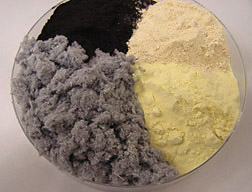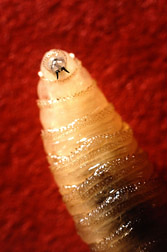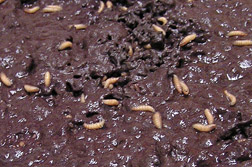Another “Turn of the Screw”-worm Saga
|
|
More than a half-century of ARS research and leadership of intensive interagency eradication efforts has kept the United States free of the screwworm, Cochliomyia hominivorax, since 1982, and Mexico since 1991. Yet efforts still continue to rid Central America of this destructive flesh-eating pest.
Screwworms are parasites that can cause great damage to domestic livestock and other warm-blooded animals. The larvae hatch from eggs laid on the host animal, often in or close to open wounds, and feed on its flesh. Cases of human infestation with screwworms have been reported as well.
Today, USDA’s Animal and Plant Health Inspection Service (APHIS) leads the screwworm fight, but ARS continues to lend its support through basic and applied research.
Central to the success in vanquishing the screwworm has been the mass-rearing of trillions of C. hominivorax flies. Young males, made sexually sterile, are air-shipped to other facilities for release in support of screwworm control programs. Mating between native females and sterilized males produces no offspring and eventually leads to the pest’s eradication.
This sterile-male-release approach to pest insect control—devised and tested in the 1950s by ARS entomologists Edward F. Knipling and Raymond C. Bushland—has also been used successfully to control fruit flies and other agricultural pests.
The screwworm-eradication effort now extends all the way through Panama, where the program is maintaining a barrier at Darien Gap, next to Colombia. There, sterile flies are released continuously to prevent northern migration and infestation by Colombian screwworms.
Currently, efforts are also being made to eradicate screwworms from Jamaica, and eventually other Caribbean islands, including Dominican Republic, Haiti, and Trinidad and Tobago. Puerto Rico was declared screwworm-free in 1976, while Aruba followed suit in 2005.
|
|
Going Meatless
The sterile-male-release method relies on efficient factory production of large quantities of the pest insect. This, in turn, depends on provision of an environment and an artificial diet appropriate for each species. For screwworms, the original diet for adults (the flies) consisted mainly of raw horsemeat and honey, which was very unpleasant for workers to handle.
That changed when researchers replaced the costly and smelly horsemeat with spray-dried eggs and replaced the honey with molasses. This major improvement was developed in the late 1990s by a team led by entomologist Muhammad F.B. Chaudhury at the ARS Screwworm Research Unit’s fly-rearing factory in Tuxtla Gutiérrez, Chiapas, Mexico.
Since being introduced in 1999, the new adult diet has saved the APHIS screwworm-release program as much as $100,000 annually. It’s been further updated by Chaudhury’s research team, which is now overseen by research leader and entomologist Steven Skoda out of the unit’s central office in Panama City, Panama.
An improved diet for immature screwworms (the larvae) uses fine cellulose fibers, made by the Central Fiber Corporation of Wellsville, Kansas, instead of shredded recycled paper or a gelling agent previously used to solidify and texturize the diet. It’s saving the eradication program even more money. Chaudhury tested this new fiber to determine its effectiveness in dispersing food particles without hindering movement of larvae throughout the medium. After 4 years of testing, the fiber-enhanced version was put into use for mass rearing at the Chiapas facility in October 2005.
This latest refinement is expected to save an additional $250,000 annually, at a production rate of 150 million flies per week. Cellulose fiber can be ordered in large quantities at a lower cost than shredded recycled paper or gel.
|
|
They Really Like It!
Research shows that the cellulose medium is producing much higher quality insects. In fact, some of the most robust flies show health and vigor comparable to wild, nonsterilized flies. Screwworm pupae reared on the new diet weigh an average of 55 milligrams (mg) each—10 mg more than those reared on the older diet.
“That’s a big, big jump,” says Chaudhury. “We believe that these larger insects will do much better in the field. At the beginning of the program, we were producing pupae in the 38- to 40-mg range, and then around 45 mg with the previous diet. Now we’ve managed to increase that considerably from our original diet.”
In addition to the cellulose fiber, the new diet contains spray-dried egg, milk substitute, and bovine blood. It has a chocolate-mousse-like color and texture. The consistency is more fluffy and airy than the previous semisolid, gel-like formulations and has lowered pupal mortality rates from 10 percent to 5 percent.
A New Factory and Lab
Skoda is working very closely with the United States-Panama Commission for the Eradication and Prevention of Screwworms—known as “COPEG,” for La Comisión Panamá-Estados Unidos para la Erradicación y Prevención del Gusano Barrenador del Ganado. COPEG, in partnership with ARS and APHIS, is currently constructing a state-of-the art screwworm rearing and research facility in Panama City.
“We’re excited about this new facility,” says Skoda. “We will continue to do research leading to reduced costs while using all the knowledge we’ve gained to produce the best sterile flies.”
The $40-million, 210-acre plant broke ground in January 2004 and was recently completed. The ARS Chiapas staff has been moving in and setting up equipment. The next phase of the eradication program will be development of genetic sexing techniques at the new lab. This could make it possible to rear only male flies, which would cut production costs dramatically.
An APHIS report estimates that the total benefit to U.S. livestock producers has been close to $900 million per year since the screwworm eradication program began.—By Alfredo Flores, Agricultural Research Service Information Staff.
This research is part of Veterinary, Medical, and Urban Entomology (#104), an ARS National Program described on the World Wide Web at www.nps.ars.usda.gov.
To reach scientists mentioned in this article, contact Alfredo Flores, USDA-ARS Information Staff, 5601 Sunnyside Ave., Beltsville, MD 20705-5129; phone (301) 504-1627, fax (301) 504-1486.
"Another “Turn of the Screw”-worm Saga" was published in the March 2007 issue of Agricultural Research magazine.









